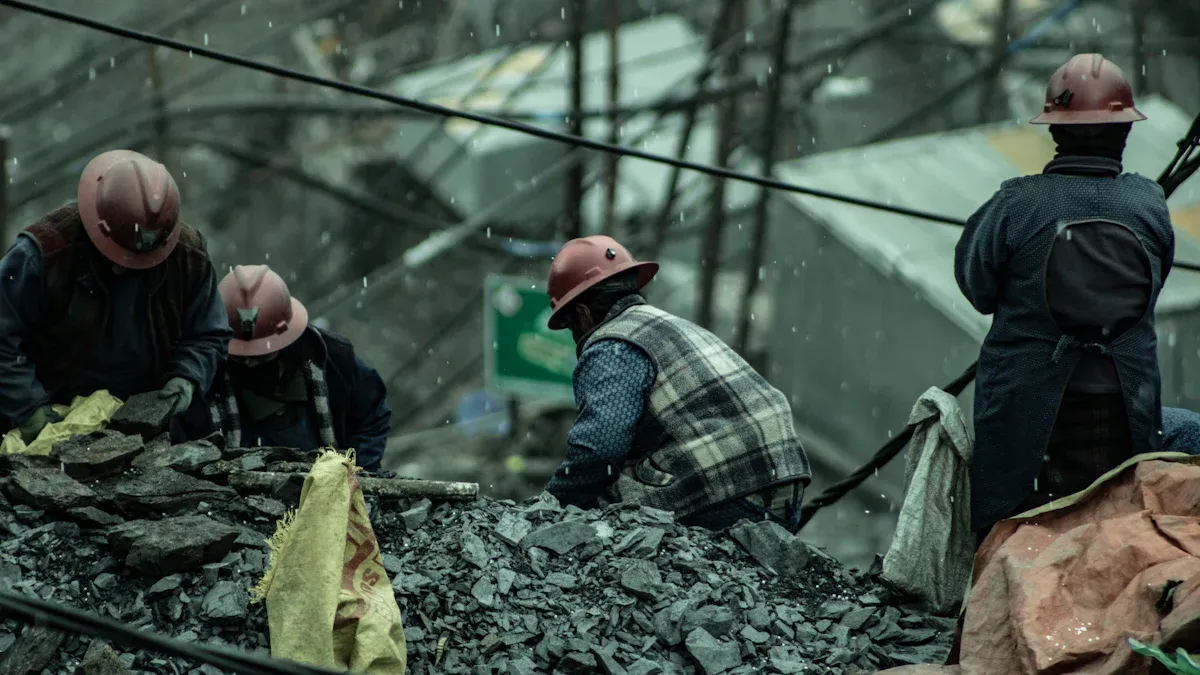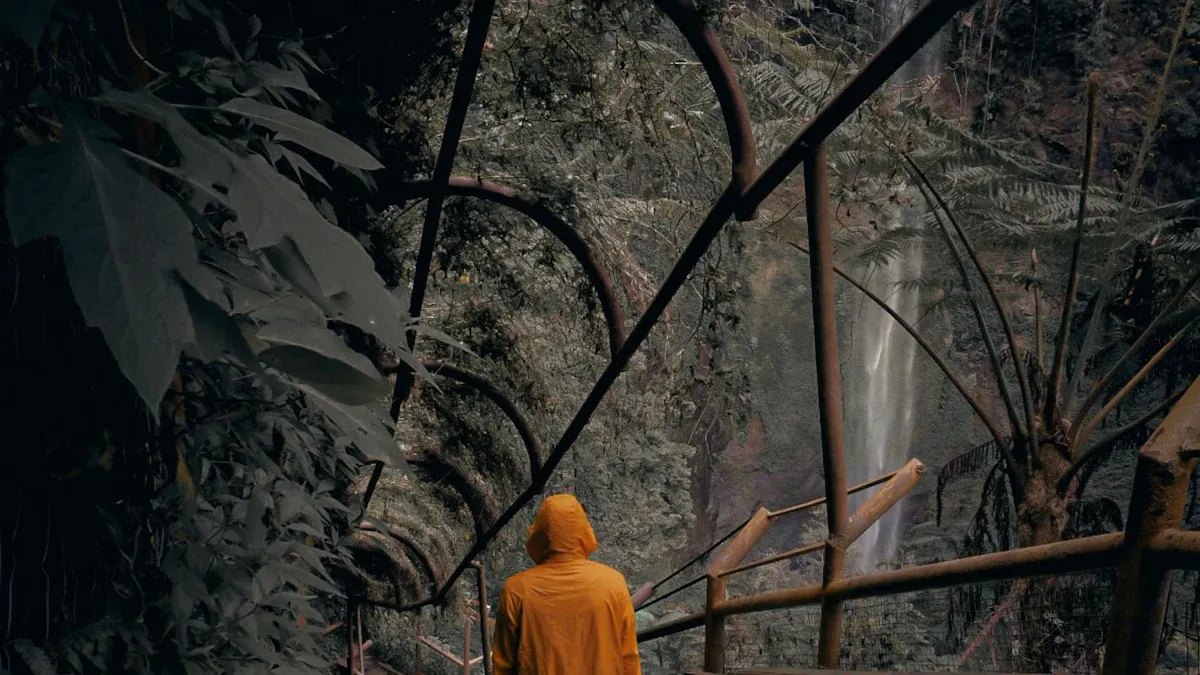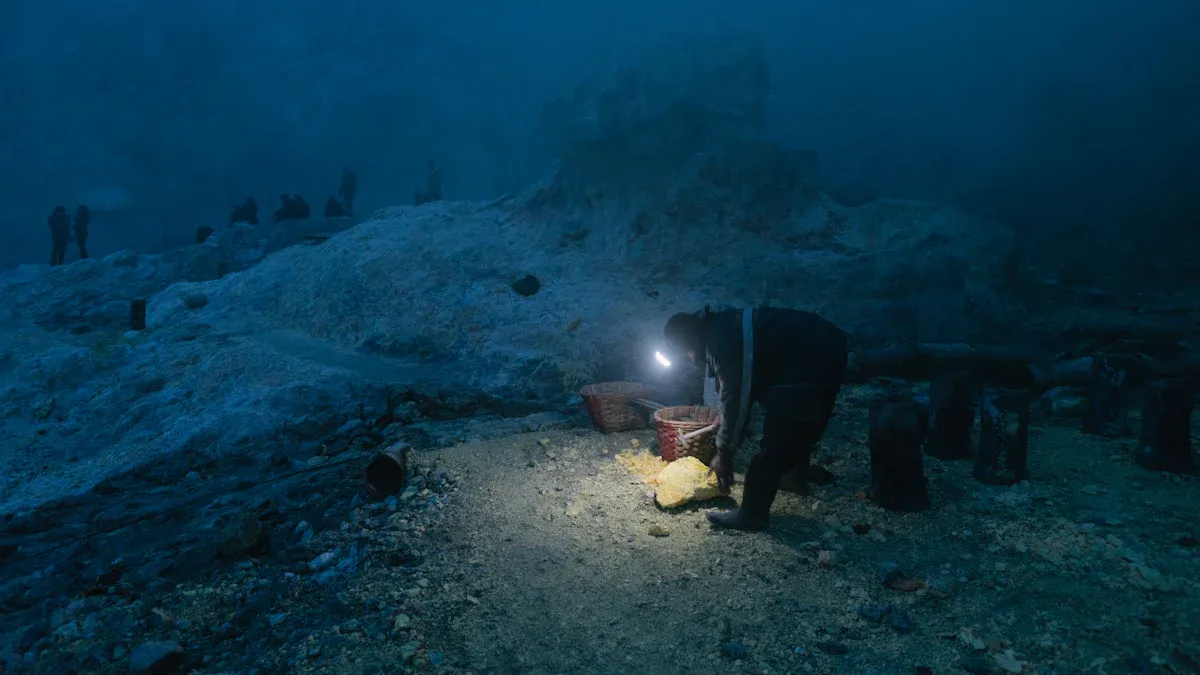Choosing the Best Flashlights for Mining and Caving Expeditions

Exploring underground environments like caves or mines demands reliable lighting. Without the right flashlight, you risk reduced visibility and compromised safety. A high-quality flashlight helps you navigate dark, uneven terrain while identifying potential hazards. You should prioritize features like durability, brightness, and battery life to ensure it meets the challenges of these rugged conditions. Flashlights designed for mining and caving often include waterproofing and impact resistance, making them essential tools for your expedition. Choosing wisely can make your journey safer and more efficient.
Key Takeaways
Pick a flashlight that is tough and can handle hard use. Materials like aluminum or titanium last a long time.
Get a flashlight with at least 600 lumens for brightness. Adjustable beams help with different tasks in caves or mines.
Choose a flashlight that works for 10 hours or more. Rechargeable batteries save money and work better over time.
Look for a waterproof flashlight with an IPX7 or IPX8 rating. This keeps it working in wet or muddy places.
Take care of your flashlight by cleaning it after use. Check for damage to make it last longer and work well.
Key Features to Look for in Mining and Caving Flashlights

Durability and Build Quality
Impact resistance for rugged environments
Mining and caving environments are harsh, with frequent exposure to rough surfaces and accidental drops. You need a flashlight that can withstand these challenges without breaking. Look for models with impact resistance ratings, as these ensure the flashlight remains functional even after falls from significant heights. A durable flashlight is essential for maintaining reliability during your expedition.
Materials that withstand wear and tear
The materials used in a flashlight determine its longevity and performance. Some of the most durable options include:
Glass-filled nylon: Strong and heat-resistant, ideal for high-temperature conditions.
PC-ABS: Tough and impact-resistant, perfect for absorbing shocks.
Aluminum alloy: Lightweight and excellent at dissipating heat.
Stainless steel: Corrosion-resistant and long-lasting.
Titanium: Premium material with superior strength and durability.
Choosing a flashlight made from these materials ensures it can handle the demands of underground exploration.
Brightness and Beam Type
Lumens and their importance underground (minimum 600 lumens recommended)
Brightness is critical when navigating dark caves or mines. A flashlight with at least 600 lumens provides sufficient light for most underground activities. However, sustained brightness over time is even more important. This ensures consistent illumination during extended trips, enhancing safety and visibility.
Wide vs. focused beam options for different tasks
Different tasks require different beam types. A wide beam is ideal for illuminating large areas, such as cave chambers. In contrast, a focused beam works better for pinpointing specific objects or navigating narrow passages. Many flashlights offer adjustable beam settings, giving you flexibility based on your needs.
Battery Life and Power Source
Rechargeable vs. disposable batteries
The choice between rechargeable and disposable batteries depends on your usage. Rechargeable batteries save money over time and deliver better performance due to lower internal resistance. For occasional use, disposable batteries may be more convenient. Consider your frequency of use and budget when deciding.
Runtime considerations for long expeditions (10+ hours recommended)
Long mining or caving trips demand a flashlight with extended runtime. A runtime of at least 10 hours ensures your light source lasts throughout the expedition. Always check the manufacturer's specifications to confirm the flashlight meets this requirement. Carrying spare batteries or a power bank can also provide additional peace of mind.
Waterproofing and Weather Resistance
IP ratings and what they mean (e.g., IPX-8 for waterproofing)
When choosing a flashlight for mining or caving, understanding IP ratings is essential. These ratings indicate how well a flashlight resists dust and water. The first digit represents protection against solid particles, while the second digit shows resistance to liquids. For example, a flashlight with an IPX8 rating can handle continuous immersion in water, making it ideal for wet environments.
Here’s a quick reference table for common IP ratings:
Level | Protection Against | Description |
|---|---|---|
0 | No Protection | No protection against liquids. |
4 | Splashing Water | Protection from splashing water in any direction. |
7 | Immersion up to 1 Meter | Can be submerged in water up to 1 meter for 30 minutes. |
8 | Continuous Immersion | Designed for prolonged immersion beyond 1 meter. |
For mining or caving, IPX7 or IPX8-rated flashlights are highly recommended. IPX7 works well for accidental submersion, while IPX8 is better for extreme conditions like flooded caves.
Protection against dust and water
Underground environments expose your flashlight to dust, mud, and water. A durable flashlight with a high IP rating ensures it remains functional in these conditions. Look for models that seal tightly to prevent dust intrusion and water damage. This feature guarantees reliable performance even in the harshest environments.
Weight and Comfort
Lightweight designs for extended use
A heavy flashlight can cause fatigue during long expeditions. Lightweight designs reduce strain, allowing you to carry them comfortably for hours. Compact models with aluminum alloy construction strike a balance between durability and weight.
Headlamp vs. handheld options
Headlamps offer hands-free convenience, making them ideal for tasks like climbing or mapping. Handheld flashlights, on the other hand, provide better control and flexibility. Choose based on your activity. For example, headlamps work well for exploring caves, while handheld flashlights excel in focused tasks like inspecting mining equipment.
Additional Features
Red light mode for preserving night vision
Red light mode is a valuable feature for caving. It preserves your night vision, allowing you to adjust to darkness quickly. This mode also reduces glare, making it easier to communicate with others in your group.
High CRI for better color visibility in dark environments
A flashlight with a high Color Rendering Index (CRI) enhances color accuracy. This feature helps you identify markings, minerals, or hazards in caves or mines. High CRI flashlights improve visibility, ensuring you don’t miss critical details.
Top Flashlight Recommendations

High-End Options
Imalent MS32 - Ultra-bright with 200,000 lumens, ideal for large cave areas
If you need a flashlight with powerful illumination for vast underground spaces, the Imalent MS32 is an excellent choice. It delivers an astonishing 200,000 lumens, making it one of the brightest flashlights available. This level of light ensures you can illuminate large cave chambers effortlessly. Its durable construction and advanced heat management system make it a reliable tool for demanding environments. The Imalent MS32 is perfect for professional cavers or miners who require maximum brightness and performance.
Fenix HP30R V2.0 - Durable, high-performance headlamp with long battery life
The Fenix HP30R V2.0 combines durability with practicality. This high-performance headlamp offers a balanced beam that provides both wide and focused light. Its long runtime ensures you won’t run out of light during extended expeditions. The rechargeable battery pack doubles as a power bank, adding versatility to this good quality flashlight. Its rugged design and waterproof rating make it a dependable choice for challenging conditions.
Budget-Friendly Options
Nitecore NU25 - Lightweight, affordable headlamp with decent brightness
The Nitecore NU25 is a compact and lightweight headlamp that delivers decent brightness for its price. It’s an affordable option for casual explorers or those on a budget. Despite its small size, it provides sufficient light for most underground activities. Its simple design and rechargeable battery make it a practical and eco-friendly choice.
Sofirn SP36 - Reliable, budget-friendly flashlight with good runtime
The Sofirn SP36 stands out among budget-friendly flashlights for its reliability and performance.
It offers a runtime of 3 hours and 13 minutes, maintaining over 5000 lumens for a significant period.
Its thermal management system keeps the flashlight comfortable to handle, even during extended use.
The well-made design ensures durability, making it a great option for those seeking a balance between cost and quality.
This flashlight provides excellent value for its price, making it a solid choice for budget-conscious adventurers.
Best for Specific Needs
Zebralight H600w Mk IV - Ideal for long battery life and compact design
The Zebralight H600w Mk IV is perfect if you prioritize long battery life and portability. Its compact design makes it easy to carry, while its efficient LED ensures consistent light output. This flashlight is ideal for extended trips where you need reliable illumination without added bulk.
ThruNite TC15 - Best for waterproofing and rugged conditions
The ThruNite TC15 excels in waterproofing and durability. Its IPX8 rating ensures it performs well in wet environments, such as flooded caves. The rugged construction withstands harsh conditions, making it a dependable flashlight for mining and caving. Its bright LED light provides excellent visibility, even in the darkest areas.
How to Evaluate Flashlights for Specific Needs
Assessing Your Environment
Mining vs. caving conditions
Understanding your environment is crucial when selecting a flashlight. Mining conditions often involve confined spaces, heavy dust, and the need for durable equipment. Caving, on the other hand, may expose you to wet surfaces, uneven terrain, and the need for versatile lighting. For mining, choose a flashlight with high impact resistance and dustproof features. For caving, prioritize waterproof flashlights with adjustable beams to handle varying light requirements. Tailoring your choice to the environment ensures safety and efficiency.
Expected duration and challenges
Consider the length of your expedition and the challenges you might face. A long trip demands a flashlight with extended runtime and reliable performance. If you expect water exposure or extreme conditions, select a durable flashlight with a high IP rating. For shorter trips, a lightweight flashlight with moderate runtime may suffice. Always anticipate potential obstacles to ensure your flashlight meets your needs.
Matching Features to Your Priorities
Importance of brightness vs. battery life
Balancing brightness and battery life is essential. High brightness levels provide better visibility but may drain the battery faster. If your priority is long-lasting light, opt for a flashlight with adjustable brightness settings. This allows you to conserve power when full brightness isn’t necessary. For tasks requiring maximum illumination, choose a flashlight with high lumens and carry spare batteries or a power bank.
Choosing between headlamps and handhelds
Your activity determines whether a headlamp or handheld flashlight suits you better. Headlamps offer hands-free convenience, making them ideal for climbing or mapping. Handheld flashlights provide better control and are perfect for inspecting equipment or focusing on specific areas. Evaluate your tasks and comfort preferences to make the right choice.
Testing Before Use
Checking beam quality and brightness
Before heading out, test your flashlight to ensure it meets your expectations. Check the beam quality by observing how evenly it distributes light. Test the brightness levels to confirm they provide adequate illumination for your environment. A quick test can prevent surprises during your expedition.
Ensuring waterproof seals are intact
Inspect the flashlight for any gaps or damage in its waterproof seals. Submerge it in water briefly to confirm its resistance. This step is especially important for caving or mining in wet conditions. Ensuring the seals are intact protects your flashlight from water damage and ensures reliable performance.
Maintenance Tips for Longevity
Proper maintenance ensures your flashlights remain reliable and effective for years. By following these tips, you can preserve their performance and durability, even in challenging environments.
Cleaning and Storage
Removing dirt and debris after use
Regular cleaning keeps your flashlight in top condition. After each use, wipe the exterior with a dry or slightly damp cloth to remove dirt and debris. Use a soft, lint-free cloth to clean the lens, avoiding abrasive materials that could scratch it. Every six months, check and replace O-rings to maintain the waterproof seal. This step is especially important for waterproof flashlights used in wet or dusty conditions.
Proper storage to prevent damage
Storing your flashlight correctly prevents unnecessary wear. Remove the batteries when not in use to avoid corrosion. Keep your flashlight in a dry, cool place to protect it from moisture and extreme temperatures. For high-end models, use a protective case to shield them from physical damage. These practices ensure your flashlight stays durable and ready for your next adventure.
Battery Care
Avoiding overcharging or deep discharges
Taking care of your flashlight’s batteries extends their lifespan. Recharge them when they reach 50% and avoid letting the charge drop below 20%. Overcharging can also harm the battery, so monitor charge levels during charging. If you store your flashlight for long periods, recharge the batteries every three months to prevent sulfation. Always use a charger designed for your battery type to maintain safety and performance.
Storing batteries safely
Proper battery storage is essential for maintaining runtime and preventing damage. Store batteries in a cool, dry place away from direct sunlight. Avoid exposing them to extreme temperatures, as this can reduce their efficiency. Keeping batteries in a dedicated storage case prevents accidental short circuits and ensures they remain in good condition.
Regular Inspections
Checking for wear and tear
Inspect your flashlight regularly to identify potential issues. For daily use, check it at least once a month. If you use it less frequently, conduct a thorough inspection every six months. Look for signs of wear, such as cracks, loose parts, or damaged seals. Regular inspections help you catch problems early and maintain the flashlight’s quality.
Replacing damaged parts promptly
Replace any damaged components immediately to ensure your flashlight remains functional. Pay special attention to the lens, O-rings, and battery contacts. Keeping these parts in good condition preserves the flashlight’s waterproof capabilities and light output. Prompt repairs or replacements prevent minor issues from becoming major problems.
Choosing the right flashlight for mining and caving expeditions ensures safety and efficiency. Focus on durability, brightness, and waterproofing when selecting your flashlight. These features help you handle the challenges of underground environments. For example, the Imalent MS32 offers unmatched brightness, while the Nitecore NU25 provides excellent value for budget-conscious explorers.
Evaluate your caving gear carefully to match your needs. A hands-free headlamp works well for extended use, while a compact flashlight suits shorter trips. Regular maintenance of your caving equipment, such as cleaning and inspecting your flashlight, ensures long-term reliability. By prioritizing quality and functionality, you can find the best hiking flashlight overall for your adventures.
FAQ
What makes a flashlight the best choice for caving?
You need a flashlight with high durability, waterproofing, and at least 600 lumens of brightness. These features ensure reliable performance in dark, wet, and rugged environments. A lightweight design also helps reduce fatigue during long caving trips.
Should you choose a headlamp or a handheld flashlight for hiking?
Headlamps work best for hands-free tasks like climbing or mapping. Handheld flashlights provide better control for inspecting specific areas. Your choice depends on your activity and comfort preferences during hiking or caving.
How do you maintain a flashlight for long-term use?
Clean your flashlight after every use to remove dirt and debris. Store it in a cool, dry place, and remove the batteries to prevent corrosion. Regularly inspect for wear and replace damaged parts promptly to ensure reliability.
Can a tactical flashlight be used for hiking?
Yes, a tactical flashlight offers durability and high brightness, making it suitable for hiking. Its rugged design ensures it withstands harsh conditions, while its compact size makes it easy to carry during your adventures.
What features should a hiking flashlight for personal protection have?
A flashlight for personal protection should have a strobe mode and high brightness. These features can disorient potential threats. A durable, waterproof design ensures it remains functional in emergencies during hiking or caving.
See Also
Selecting The Perfect Headlamp Flashlight For Your Needs
Essential Tips For Picking The Best Flashlight For Hiking
Finding The Ideal Rechargeable Flashlight For Your Hikes
Guidelines For Selecting The Best Flashlight For Camping
Brighten Your Outdoor Experiences With A Powerful Flashlight
